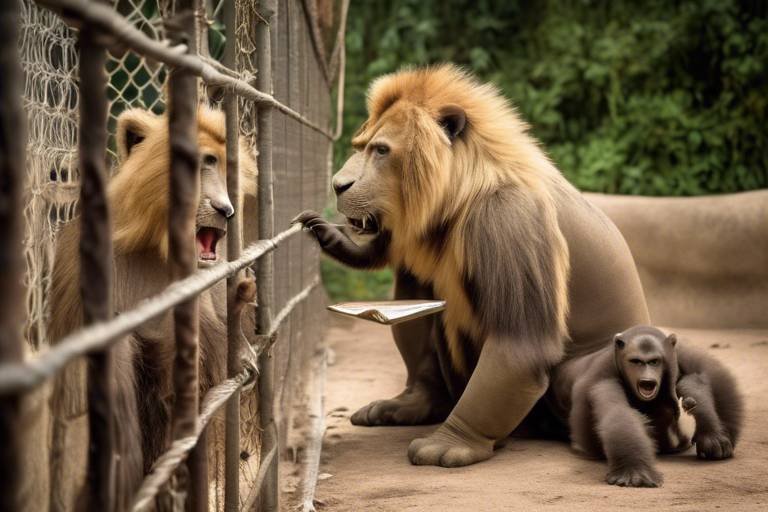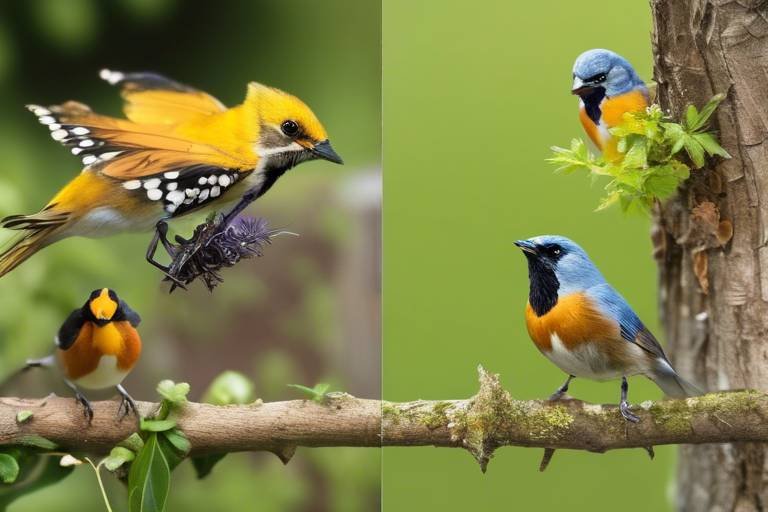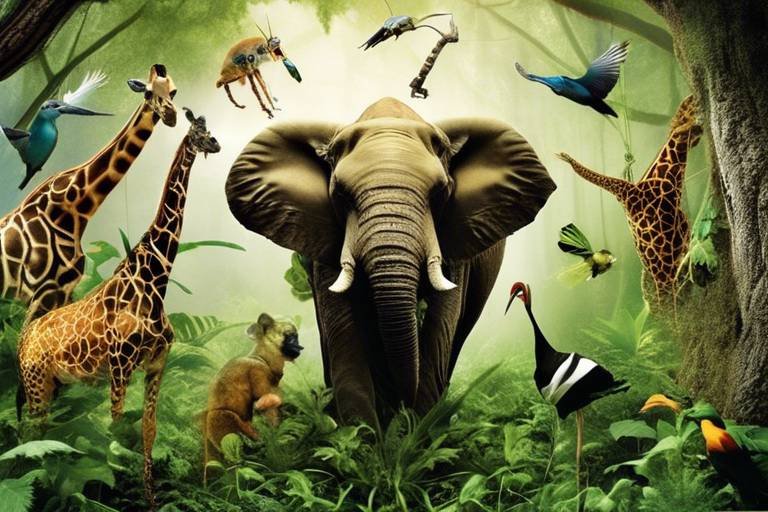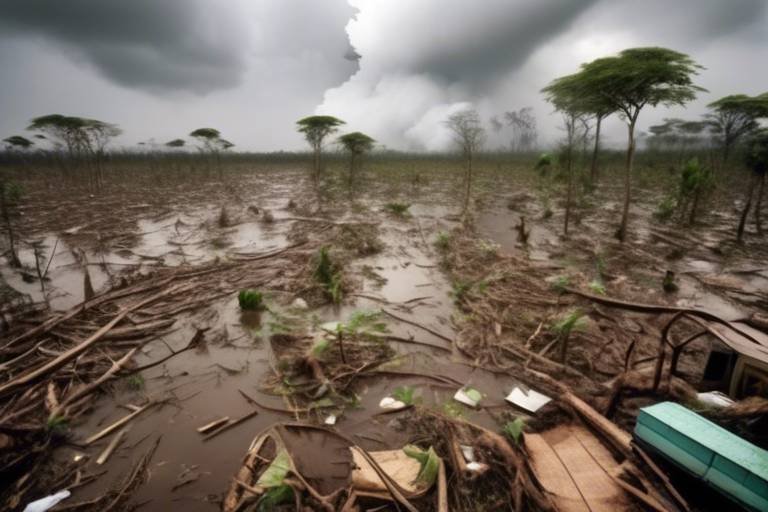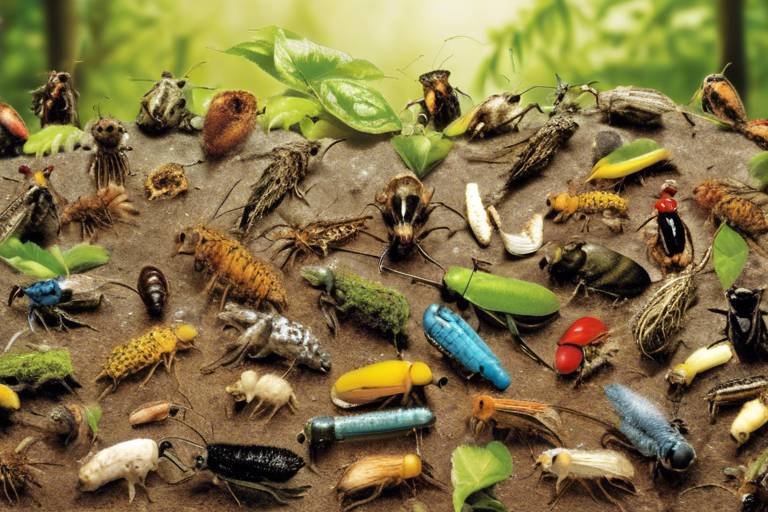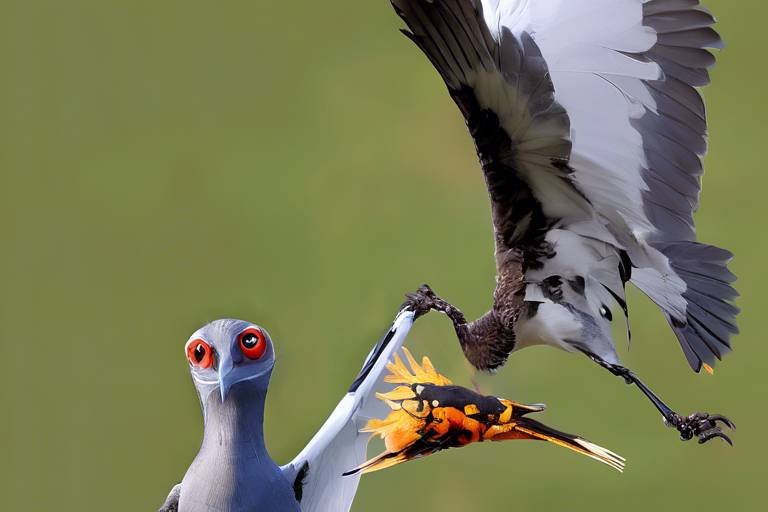Fight Against Biodiversity Loss: A Call to Urban Planners
In today's rapidly urbanizing world, the fight against biodiversity loss has never been more urgent. Urban planners hold a critical role in this battle, as they shape the environments where millions of people live, work, and play. With cities expanding at an unprecedented rate, the natural habitats that once thrived are being replaced by concrete jungles. This transformation not only affects the flora and fauna that call these areas home but also impacts the quality of life for urban residents. Imagine a city where the air is cleaner, the water is purer, and the sounds of nature can be heard amidst the urban hustle. This vision is not just a dream; it can become a reality through thoughtful urban planning that prioritizes biodiversity.
The connection between urban development and biodiversity is intricate and profound. As urban planners, the choices made today will resonate for generations to come. By integrating sustainable practices into city designs, planners can create spaces that not only accommodate human needs but also enhance the ecosystems that sustain us. This article will delve into the importance of biodiversity, the impacts of urbanization, and the essential role that urban planners play in fostering a harmonious coexistence between nature and urban life.
Biodiversity is not just a buzzword; it is the backbone of healthy ecosystems. It contributes to the resilience of our environment, helping it withstand changes and recover from disturbances. Urban planners can harness the power of biodiversity to provide vital services such as clean air, water filtration, and food security. By recognizing the value of biodiversity, we can create urban spaces that are not only livable but also thriving ecosystems.
As we navigate this complex landscape, it is essential to remember that urban planning is not just about buildings and roads; it is about creating a sustainable future where both humans and wildlife can flourish. The time for action is now, and urban planners are at the forefront of this movement. Together, we can pave the way for cities that respect and nurture the natural world, ensuring that biodiversity is preserved for future generations.
Understanding biodiversity is essential for appreciating its role in ecosystem health, resilience, and the services it provides, including clean air, water, and food security for urban populations. Biodiversity refers to the variety of life on Earth, encompassing all living organisms, their genetic differences, and the ecosystems they form. In urban environments, biodiversity contributes to a range of benefits, such as reducing pollution, enhancing mental well-being, and supporting local economies through tourism and recreation.
The significance of biodiversity extends beyond mere aesthetics; it plays a crucial role in maintaining the balance of our ecosystems. A diverse range of species can better withstand environmental changes, such as climate shifts or disease outbreaks. Urban planners must recognize that every decision made in the design of our cities can have far-reaching effects on biodiversity. By prioritizing green spaces, parks, and natural habitats, planners can create urban environments that support a rich tapestry of life.
Urbanization significantly alters natural habitats, leading to biodiversity loss. As cities expand, they encroach upon the habitats of countless species, resulting in habitat destruction, pollution, and increased competition for resources. This section examines the consequences of urban sprawl on local ecosystems and species diversity. Urban sprawl often leads to the fragmentation of habitats, where large, continuous areas of natural land are broken up into smaller, isolated patches.
The consequences of such fragmentation are profound. Species that once thrived in these habitats find themselves trapped in small, isolated pockets, making it difficult to find mates, food, or shelter. This isolation can lead to a decline in genetic diversity, making populations more vulnerable to disease and environmental changes. The loss of biodiversity in urban areas can also disrupt essential ecosystem services, such as pollination and pest control, which are vital for human survival.
Habitat fragmentation disrupts ecosystems, isolating species and reducing genetic diversity. This part discusses the effects of fragmented habitats in urban areas and potential solutions. Urban planners must be aware of the impacts of their designs on local ecosystems. Strategies such as creating wildlife corridors or preserving existing green spaces can help mitigate the effects of fragmentation. By ensuring that habitats are connected, planners can facilitate species movement and promote biodiversity within urban settings.
Creating green corridors can help mitigate habitat fragmentation by connecting isolated habitats, allowing for species movement and promoting biodiversity within urban settings. These corridors serve as lifelines for wildlife, enabling them to traverse urban landscapes safely. Imagine a network of parks and green spaces that not only beautify our cities but also support the movement of birds, mammals, and insects.
Restoration projects aim to rehabilitate degraded habitats, enhancing biodiversity. This section highlights successful urban restoration initiatives and their positive impacts on local ecosystems. Urban planners can play a pivotal role in spearheading these projects, transforming abandoned lots into thriving green spaces. Successful restoration projects not only benefit wildlife but also enhance the quality of life for residents, providing spaces for recreation and relaxation.
Urban environments challenge species to adapt to new conditions. This section explores how certain species thrive in cities and the implications for biodiversity management. Some species have shown remarkable resilience, adapting to urban life in ways that surprise us. For instance, urban birds often learn to exploit human-made structures for nesting and foraging. Understanding these adaptations is crucial for effective biodiversity management in our cities.
Urban planners are pivotal in integrating biodiversity considerations into city designs. This section discusses their responsibilities in promoting sustainable development practices that protect ecosystems. By prioritizing biodiversity in urban planning, we can create cities that are not only functional but also vibrant ecosystems. This involves a holistic approach that considers the needs of both people and wildlife.
Effective policy development is crucial for biodiversity conservation. This part outlines strategies planners can adopt to implement biodiversity-friendly policies in urban planning processes. Policies should encourage the preservation of existing ecosystems, promote green infrastructure, and support community engagement in biodiversity initiatives.
Engaging communities in biodiversity initiatives fosters awareness and support. This section emphasizes the importance of public involvement in urban biodiversity conservation efforts. When communities are actively involved in conservation efforts, they are more likely to appreciate and protect their local ecosystems. Urban planners can facilitate this engagement by organizing workshops, community clean-ups, and educational programs that highlight the importance of biodiversity.
- What is biodiversity, and why is it important?
Biodiversity refers to the variety of life on Earth, including different species, genetic variations, and ecosystems. It is crucial for ecosystem health, resilience, and providing essential services like clean air and water. - How does urbanization affect biodiversity?
Urbanization leads to habitat destruction, pollution, and fragmentation, which can significantly reduce species diversity and disrupt ecosystem services. - What can urban planners do to promote biodiversity?
Urban planners can create green spaces, implement wildlife corridors, and engage communities in conservation efforts to support biodiversity in urban areas.

The Importance of Biodiversity
Biodiversity is more than just a buzzword; it's the lifeblood of our planet. Imagine a world where every living organism, from the tiniest microbe to the tallest tree, plays a role in a grand symphony of life. This intricate web of life is essential for maintaining the health of ecosystems, which in turn supports human existence. Biodiversity contributes to numerous ecosystem services that we often take for granted, such as clean air, water filtration, and fertile soil. Without these services, our urban environments would struggle to thrive, and we would face dire consequences.
In urban areas, where concrete often reigns supreme, the presence of diverse species can significantly enhance our quality of life. For instance, green spaces filled with various plants and animals can help improve air quality by absorbing pollutants and releasing oxygen. This is crucial, especially in cities where air pollution is a major concern. Additionally, biodiversity can play a vital role in food security. Diverse ecosystems are more resilient and can better withstand environmental changes, ensuring a stable food supply for urban populations. As we delve deeper into the importance of biodiversity, it's clear that protecting it is not just an environmental issue; it's a matter of public health and safety.
Furthermore, biodiversity enriches our lives in ways that go beyond the physical. It offers us opportunities for recreation, education, and cultural enrichment. Have you ever taken a stroll through a park and marveled at the variety of flowers, birds, and insects? These experiences foster a sense of connection to nature and contribute to our mental well-being. Urban biodiversity can also enhance property values and attract tourism, creating economic benefits for cities. In short, biodiversity is not just beneficial; it is essential for the sustainability of urban life.
To put it into perspective, consider the following statistics:
| Service | Benefit |
|---|---|
| Air Quality Regulation | Reduces respiratory diseases and improves overall health |
| Water Filtration | Ensures access to clean drinking water |
| Pollination | Supports food production and biodiversity |
| Climate Regulation | Mitigates the effects of climate change |
In conclusion, the importance of biodiversity cannot be overstated. It is the foundation upon which our urban ecosystems are built, providing essential services that sustain life. As urban planners, we must recognize the value of biodiversity and incorporate it into our designs and policies. By doing so, we can create healthier, more sustainable cities that not only benefit humans but also the myriad of species with whom we share our environment.
- What is biodiversity? Biodiversity refers to the variety of life forms in a particular habitat or ecosystem, including the diversity of species, genetic variation, and ecosystem diversity.
- Why is biodiversity important in urban areas? Biodiversity in urban areas helps improve air quality, provides recreational spaces, supports food security, and enhances overall well-being.
- How can urban planners promote biodiversity? Urban planners can promote biodiversity by integrating green spaces, creating wildlife corridors, and implementing policies that protect natural habitats.

Urbanization and Its Impact
Urbanization is like a double-edged sword; while it brings progress and development, it also wreaks havoc on our natural ecosystems. As cities expand, they consume vast amounts of land that were once home to diverse species and rich habitats. This rapid transformation is not just a change in scenery; it has profound implications for biodiversity. Imagine a vibrant forest, teeming with life, suddenly replaced by concrete jungles and asphalt. The consequences of this shift are alarming, leading to a significant decline in species diversity and the degradation of essential ecosystem services.
One of the most pressing issues caused by urbanization is habitat loss. When we pave over green spaces to make room for buildings and roads, we effectively erase the homes of countless species. This loss of habitat not only threatens the survival of these organisms but also disrupts the intricate balance of the ecosystems they inhabit. The natural world is interconnected, and when one piece is removed, the entire system feels the impact. For example, the decline of pollinators like bees and butterflies due to urban sprawl can lead to decreased plant reproduction, which in turn affects food supplies for other wildlife.
Furthermore, urbanization leads to habitat fragmentation, a phenomenon where large habitats are broken into smaller, isolated patches. This fragmentation can be likened to an intricate puzzle where some pieces are lost, making it difficult for species to find mates, food, and shelter. As a result, populations become isolated, leading to reduced genetic diversity and increased vulnerability to extinction. Urban areas, with their busy roads and towering buildings, can act as barriers that prevent wildlife from moving freely, exacerbating the challenges faced by many species.
To illustrate the impact of urbanization on biodiversity, consider the following table, which outlines some of the key effects:
| Impact of Urbanization | Description |
|---|---|
| Habitat Loss | Destruction of natural habitats due to land conversion for urban development. |
| Habitat Fragmentation | Breaking up of large habitats into smaller, isolated patches, making it difficult for species to thrive. |
| Pollution | Increased pollution from vehicles and industries, affecting air and water quality. |
| Invasive Species | Urban areas often facilitate the spread of invasive species that outcompete native flora and fauna. |
Moreover, urban areas can become hotbeds for pollution, another significant threat to biodiversity. The air we breathe and the water we drink are compromised by emissions from vehicles, industrial activities, and waste disposal. This pollution doesn't just affect humans; it has a cascading effect on wildlife, leading to health issues and population declines. Additionally, urban environments often provide a pathway for invasive species to thrive, further jeopardizing native species that are already struggling to adapt to the changing landscape.
In conclusion, the impact of urbanization on biodiversity is profound and multifaceted. It is crucial for urban planners to recognize these challenges and actively seek solutions that promote sustainable development. By prioritizing green spaces, creating wildlife corridors, and implementing eco-friendly policies, we can mitigate the adverse effects of urbanization and foster a healthier coexistence between humans and nature.
- What is biodiversity? Biodiversity refers to the variety of life in a particular habitat or ecosystem, including species diversity, genetic diversity, and ecosystem diversity.
- How does urbanization affect wildlife? Urbanization leads to habitat loss, fragmentation, and pollution, all of which threaten wildlife survival and ecosystem health.
- What can urban planners do to support biodiversity? Urban planners can create green spaces, implement wildlife corridors, and develop policies that prioritize environmental sustainability.
- Why are green corridors important? Green corridors connect fragmented habitats, allowing wildlife to move freely, which helps maintain genetic diversity and ecosystem resilience.

Habitat Fragmentation
Habitat fragmentation is like taking a beautiful puzzle and smashing it into a hundred pieces. Each piece may still have its own charm, but without the complete picture, the integrity of the ecosystem is compromised. When cities expand, they often slice through natural landscapes, creating isolated patches of habitat that can no longer support the diverse life that once thrived there. This disruption can lead to a cascade of negative effects, including the isolation of species, reduced genetic diversity, and the eventual decline of populations.
Imagine a once-vibrant forest, now split by roads and buildings. The animals that used to roam freely now find themselves trapped in small, disconnected areas. This isolation makes it difficult for species to find mates, leading to inbreeding and a lack of genetic diversity, which are critical for adapting to changing environments. Moreover, fragmented habitats can hinder the migration patterns of various species, disrupting their access to food and shelter. For instance, birds that migrate may find it challenging to locate suitable stopover habitats, while pollinators like bees struggle to navigate between fragmented wildflower patches.
To better understand the impact of habitat fragmentation, let’s consider a few key consequences:
- Loss of Biodiversity: As habitats shrink and become isolated, the number of species that can survive in these areas diminishes.
- Increased Competition: With fewer resources available, species may be forced to compete more fiercely for food and shelter.
- Altered Ecosystem Functions: The loss of certain species can disrupt the balance of ecosystems, affecting things like pollination, seed dispersal, and nutrient cycling.
Fortunately, urban planners have a vital role to play in addressing habitat fragmentation. By designing cities that incorporate green spaces and wildlife corridors, they can help reconnect fragmented habitats. For example, creating green bridges or tunnels that allow animals to cross busy roads safely can significantly enhance species movement and promote genetic diversity. Restoration projects that focus on re-establishing native vegetation can also play a crucial role in creating a more cohesive ecosystem.
In conclusion, habitat fragmentation is a pressing issue that urban environments must confront. By understanding its impacts and implementing smart planning strategies, we can pave the way for healthier ecosystems that support a rich tapestry of life. The challenge lies in balancing urban development with the need to preserve our natural heritage, ensuring that future generations can enjoy the beauty and benefits of biodiversity.
What is habitat fragmentation?
Habitat fragmentation occurs when large, continuous habitats are divided into smaller, isolated patches due to human activities such as urbanization, agriculture, and infrastructure development.
How does habitat fragmentation affect biodiversity?
It leads to reduced species populations, increased competition for resources, and a decline in genetic diversity, making it harder for species to adapt to environmental changes.
What can urban planners do to mitigate habitat fragmentation?
Urban planners can create green corridors, wildlife crossings, and restore degraded habitats to connect isolated ecosystems and support species movement.
Why is genetic diversity important?
Genetic diversity is essential for the survival of species. It enables populations to adapt to changing environments, resist diseases, and maintain healthy ecosystems.
Can urban areas support biodiversity?
Yes, urban areas can support biodiversity through thoughtful planning, incorporating green spaces, and engaging communities in conservation efforts.

Green Corridors
Green corridors are like lifelines for urban biodiversity, acting as essential pathways that connect fragmented habitats within a city. Imagine a bustling metropolis where concrete jungles dominate the landscape, yet amidst this chaos, there are strips of greenery, parks, and natural areas that allow wildlife to thrive. These corridors not only facilitate the movement of species but also promote genetic diversity, which is crucial for the survival of many plants and animals. By creating these green passages, urban planners can help mitigate the negative impacts of urbanization on local ecosystems.
One of the most significant benefits of green corridors is their ability to provide safe passage for various species. For instance, migratory birds can use these routes to travel between feeding and nesting sites without the threat of urban obstacles. Similarly, small mammals and insects can navigate through these corridors, ensuring they have access to the resources they need to survive. This is particularly important in urban areas where natural habitats have been severely reduced. The presence of green corridors can significantly enhance the overall biodiversity of a city, making it a more resilient environment.
Moreover, green corridors serve multiple functions that go beyond just supporting wildlife. They can improve air quality, reduce urban heat, and provide recreational spaces for residents. When people have access to green spaces, they tend to lead healthier lifestyles, both physically and mentally. It’s a win-win situation! Urban planners must consider incorporating these corridors into their designs, ensuring that they are not just an afterthought but a fundamental component of urban development.
To illustrate the impact of green corridors, let’s take a look at some successful examples from around the globe:
| City | Green Corridor Initiative | Impact |
|---|---|---|
| New York City | The High Line | Transformed an abandoned railway into a vibrant park, boosting local biodiversity and community engagement. |
| London | Green Grid | Connected parks and green spaces, enhancing wildlife habitats and improving air quality. |
| Melbourne | Yarra River Corridor | Restored natural habitats along the river, supporting diverse flora and fauna. |
As we can see, the implementation of green corridors has led to remarkable benefits in various cities. Urban planners have the opportunity to create these vital connections that not only support wildlife but also enhance the quality of life for urban dwellers. It’s essential to recognize that the health of our urban ecosystems directly correlates with the health of our communities. By prioritizing green corridors in urban planning, we take a significant step towards a more sustainable and biodiverse future.
- What are green corridors? Green corridors are designated pathways of vegetation that connect fragmented habitats in urban areas, allowing wildlife to move freely and safely.
- How do green corridors benefit cities? They improve biodiversity, enhance air quality, provide recreational spaces, and contribute to the overall well-being of urban residents.
- Can green corridors be integrated into existing urban spaces? Yes, urban planners can retrofit existing environments to include green corridors by transforming underutilized areas into green spaces.
- What types of species benefit from green corridors? A wide range of species, including birds, mammals, insects, and plants, can benefit from the connectivity provided by green corridors.

Restoration Projects
Restoration projects are like a breath of fresh air for our urban ecosystems. They serve as a beacon of hope, showing us that even in the concrete jungles we call cities, nature can bounce back if given a chance. These initiatives aim to rehabilitate degraded habitats, bringing back not just the greenery but also the vibrant life that once thrived there. Imagine transforming a barren lot into a flourishing park, complete with native plants and wildlife. It’s not just about aesthetics; it’s about creating a healthier environment for both humans and animals.
One of the most compelling aspects of restoration projects is their ability to enhance biodiversity. By reintroducing native species and creating suitable habitats, these projects can significantly increase the variety of life in urban areas. For example, consider the High Line in New York City. Once an abandoned railway, it has been transformed into a stunning elevated park that supports a diverse array of plants and animals. This project not only beautified the city but also provided a vital habitat for various species, proving that urban spaces can coexist with nature.
Successful restoration projects often share some common features. They typically include:
- Community Involvement: Engaging local residents in the planning and implementation phases ensures that the project meets the needs of the community while fostering a sense of ownership.
- Native Plant Selection: Using indigenous plants helps restore the natural ecosystem and provides food and shelter for local wildlife.
- Continuous Monitoring: Ongoing assessment of the restored areas helps track progress and make necessary adjustments to improve ecological outcomes.
Moreover, restoration projects can serve as educational platforms. They provide opportunities for community members to learn about local ecosystems, the importance of biodiversity, and how they can contribute to conservation efforts. Imagine children planting trees and learning about the critical role these trees play in their environment. Such hands-on experiences can inspire the next generation of environmental stewards.
In conclusion, restoration projects are not just about planting trees or creating parks; they are about revitalizing our connection to nature within urban landscapes. They remind us that with dedication and community involvement, we can reclaim lost habitats and foster biodiversity, creating a more sustainable future for all living beings. The ripple effects of these projects can be profound, influencing everything from air quality to mental well-being. So, the next time you hear about a restoration project in your area, consider getting involved—it’s a chance to be part of something bigger than yourself!
1. What are restoration projects?
Restoration projects are initiatives aimed at rehabilitating degraded ecosystems to improve biodiversity and restore natural habitats.
2. How do restoration projects benefit urban areas?
They enhance local biodiversity, improve air and water quality, provide recreational spaces, and foster community engagement.
3. Can anyone participate in restoration projects?
Yes! Many projects welcome volunteers from the community to help with planting, maintenance, and educational activities.
4. What types of species are typically reintroduced in restoration projects?
Native species are usually prioritized as they are better adapted to the local environment and can thrive alongside existing wildlife.
5. How can I find restoration projects in my area?
You can check with local environmental organizations, community centers, or city planning departments for information on upcoming projects.

Species Adaptation
Urban environments present a unique set of challenges for wildlife, forcing species to adapt in ways that are often surprising and innovative. Just think about it: cities are like bustling beehives, filled with noise, pollution, and a constant influx of people. In this chaotic setting, some species not only survive but actually thrive! This phenomenon raises an intriguing question: how do these urban dwellers manage to navigate their new, concrete jungles?
One of the most fascinating aspects of species adaptation is the ability of certain animals to adjust their behavior and physiology to suit their urban surroundings. For instance, birds like the house sparrow and the rock pigeon have become synonymous with city life. They’ve learned to exploit the abundance of food sources, such as discarded fast food and seeds from urban gardens. Additionally, these birds often nest in the nooks and crannies of buildings, showcasing their remarkable flexibility in habitat selection.
Moreover, urban heat islands—areas that experience higher temperatures than their rural counterparts—have also influenced species adaptation. Some species, like the red fox, have taken advantage of warmer urban environments, allowing them to extend their range and thrive in areas that were previously inhospitable. This adaptability is not just a testament to their resilience; it also highlights the intricate relationship between urbanization and wildlife survival.
However, not all species are so fortunate. Many are struggling to cope with the rapid changes brought about by urbanization. For example, species with specialized habitat requirements or those that are less mobile may find it increasingly difficult to adapt. This brings us to an essential point: while some species flourish, others face significant threats, leading to a decline in biodiversity. This dichotomy emphasizes the need for effective biodiversity management strategies.
To better understand the impact of urbanization on species adaptation, let’s take a look at the following table that summarizes how different species respond to urban environments:
| Species | Adaptation Strategy | Outcome |
|---|---|---|
| House Sparrow | Utilizes urban food sources | Population growth in cities |
| Red Fox | Adapts to urban heat | Expanded range |
| Great Horned Owl | Nests in urban parks | Stable population |
| Butterflies | Changes in migration patterns | Population decline |
As we can see, the responses vary significantly among species. Some manage to find their niche in the urban ecosystem, while others struggle to adapt. This disparity is crucial for urban planners to consider when designing cities. After all, creating spaces that accommodate diverse species can foster a richer urban biodiversity.
In conclusion, species adaptation in urban environments is a complex and multifaceted issue. It’s not just about survival; it’s about finding ways to coexist with human development. As urban planners, we have a vital role in shaping the future of our cities, ensuring that they are not only livable for people but also for the incredible array of wildlife that shares our urban spaces.
- What is species adaptation? Species adaptation refers to the process by which species evolve and adjust their behaviors, physiology, and morphology to survive in changing environments.
- How does urbanization affect biodiversity? Urbanization leads to habitat loss, fragmentation, and pollution, which can significantly reduce biodiversity and threaten the survival of many species.
- What can urban planners do to support biodiversity? Urban planners can create green spaces, implement wildlife corridors, and promote sustainable practices to protect and enhance urban biodiversity.
- Are there any successful examples of urban biodiversity initiatives? Yes, many cities have implemented successful initiatives, such as urban reforestation projects and the creation of wildlife-friendly parks that support diverse species.

Role of Urban Planners
Urban planners are the unsung heroes in the battle against biodiversity loss. Their decisions shape the very fabric of our cities, influencing everything from the layout of parks to the design of transportation systems. The role they play is not just about aesthetics or functionality; it’s about creating environments that nurture both people and nature. Imagine a city where vibrant green spaces coexist with bustling urban life, where wildlife can thrive alongside human activity. This vision is achievable, but it requires a committed effort from urban planners to integrate biodiversity considerations into their designs.
At the heart of this responsibility lies the necessity for sustainable development practices. Urban planners must think beyond immediate needs and consider the long-term impacts of their projects on local ecosystems. This means advocating for policies that prioritize green spaces, protect existing habitats, and promote biodiversity-friendly practices. For instance, when planning new developments, urban planners can incorporate features such as green roofs, rain gardens, and permeable pavements that not only enhance the urban landscape but also provide crucial habitats for various species.
Moreover, effective policy development is crucial for biodiversity conservation. Urban planners can take the lead in drafting policies that encourage sustainable land use and protect natural resources. This could involve zoning laws that restrict development in sensitive areas or incentives for developers who incorporate ecological features into their projects. By establishing a framework that values biodiversity, planners can ensure that urban growth does not come at the expense of the natural world.
Another vital aspect of a planner's role is community engagement. It’s essential to involve local communities in biodiversity initiatives, fostering a sense of ownership and stewardship. When residents are educated about the importance of biodiversity and how it affects their daily lives, they are more likely to support conservation efforts. Urban planners can organize workshops, community meetings, and educational programs to raise awareness and gather input from the public. This collaborative approach not only enhances the projects but also builds a community that is invested in protecting its natural heritage.
In summary, urban planners hold a pivotal position in the fight against biodiversity loss. Their ability to influence urban design and policy can lead to healthier ecosystems and more sustainable cities. By prioritizing biodiversity in their planning processes, they can create urban environments that are not only functional but also rich in life. As we move forward, it is imperative that urban planners embrace this responsibility, paving the way for a greener, more vibrant future.
- What is the role of urban planners in biodiversity conservation?
Urban planners integrate biodiversity considerations into city designs, promoting sustainable development practices that protect ecosystems. - How can urban planners promote community engagement?
By organizing workshops and educational programs, urban planners can raise awareness and involve local communities in biodiversity initiatives. - What are some sustainable practices urban planners can implement?
Incorporating green roofs, rain gardens, and permeable pavements are just a few examples of how planners can enhance urban biodiversity.

Policy Development
When it comes to the fight against biodiversity loss, effective policy development is not just a box to check; it's a fundamental cornerstone. Urban planners hold the key to crafting policies that not only recognize the importance of biodiversity but also actively promote its conservation within our cities. Think of urban planning as a complex puzzle where each piece represents a different aspect of city life—from transportation to housing, and yes, even the green spaces that nurture our urban ecosystems.
To truly make a difference, urban planners must first understand the intricate relationships between urban development and biodiversity. This means recognizing that every time a new building goes up or a road is paved, there are ripple effects that can disrupt local ecosystems. Hence, planners should adopt a proactive approach, incorporating biodiversity considerations from the very beginning of the planning process. This can be achieved through a variety of strategies, including:
- Integrating Green Spaces: Policies should encourage the inclusion of parks, gardens, and green roofs in urban designs. These spaces serve as vital habitats for various species and contribute to the overall health of the environment.
- Promoting Sustainable Practices: Urban planners can advocate for sustainable construction practices that minimize environmental impact, such as using recycled materials and reducing waste.
- Establishing Biodiversity Goals: Setting clear, measurable objectives for biodiversity conservation can guide urban development and ensure that ecological considerations remain a priority.
Moreover, policies should not only focus on the present but also consider the long-term implications of urbanization on biodiversity. This involves conducting thorough environmental impact assessments and engaging with scientists, ecologists, and community members to gather diverse perspectives. By fostering a collaborative approach, planners can develop policies that are both innovative and effective.
In addition, the role of technology in policy development cannot be overlooked. Urban planners can leverage tools like Geographic Information Systems (GIS) to map out critical habitats and biodiversity hotspots within urban areas. This data-driven approach can help planners make informed decisions that prioritize conservation efforts. For instance, a city might use GIS to identify areas that are crucial for migratory birds and ensure that these zones are protected from urban encroachment.
Ultimately, the success of biodiversity-friendly policies hinges on community engagement. When local residents are involved in the planning process, they are more likely to support and advocate for initiatives that protect their environment. Planners should create opportunities for public input, whether through town hall meetings, surveys, or community workshops. By listening to the voices of the community, planners can tailor policies that resonate with the needs and values of the people they serve.
In conclusion, policy development in urban planning is a dynamic and essential process that can significantly impact biodiversity conservation. By integrating ecological considerations into every facet of urban design, planners can help create cities that not only thrive economically but also cherish and protect the natural world around them. The road ahead may be challenging, but with thoughtful policies and active community involvement, we can pave the way for a greener, more sustainable urban future.
- What is biodiversity, and why is it important? Biodiversity refers to the variety of life in a particular habitat or ecosystem. It's crucial for ecosystem health, providing services like clean air, water, and food security.
- How does urbanization affect biodiversity? Urbanization leads to habitat destruction, fragmentation, and pollution, which can significantly reduce species diversity and disrupt ecosystems.
- What can urban planners do to promote biodiversity? Urban planners can integrate green spaces, promote sustainable practices, and engage with communities to create policies that protect and enhance biodiversity.

Community Engagement
When it comes to biodiversity conservation in urban settings, the role of community engagement cannot be overstated. Imagine a vibrant city where residents not only live among nature but actively contribute to its preservation. This vision can become a reality when urban planners harness the power of local communities. Engaging the community in biodiversity initiatives fosters a sense of ownership and responsibility, creating a collective effort to protect the environment. But how do we spark this engagement?
Firstly, it's essential to create platforms for dialogue. Urban planners should organize workshops and community meetings that invite residents to share their thoughts and ideas. These gatherings can serve as a melting pot of creativity, where innovative solutions for biodiversity challenges can emerge. When people feel heard and valued, their willingness to participate in conservation efforts increases exponentially. For instance, a neighborhood clean-up event can transform into a larger movement when residents see the tangible impact of their actions.
Moreover, education plays a crucial role in community engagement. By providing information about local ecosystems and the importance of biodiversity, planners can empower residents to make informed decisions. Schools can integrate biodiversity topics into their curricula, encouraging children to become stewards of the environment from a young age. Imagine children learning about the local flora and fauna and then sharing that knowledge with their families. This ripple effect can lead to a more environmentally conscious community.
Additionally, urban planners should consider forming partnerships with local organizations and NGOs that focus on environmental issues. These collaborations can amplify community engagement efforts, bringing in resources and expertise that planners might lack. For example, a partnership with a local wildlife organization can lead to the establishment of community gardens or native plant nurseries, fostering biodiversity right in the heart of the city.
To further enhance community involvement, urban planners can create incentive programs that reward residents for participating in biodiversity initiatives. This could include discounts at local businesses for those who volunteer in conservation efforts or recognition programs for neighborhoods that implement sustainable practices. When people see that their contributions are valued, they are more likely to engage actively.
In summary, community engagement is a vital ingredient in the fight against biodiversity loss in urban areas. By fostering dialogue, providing education, forming partnerships, and creating incentives, urban planners can ignite a passion for biodiversity within communities. The result? A thriving urban ecosystem where both people and nature coexist harmoniously, benefiting everyone involved.
- Why is community engagement important for biodiversity conservation?
Community engagement fosters a sense of ownership and responsibility among residents, leading to increased participation in conservation efforts. - How can urban planners effectively engage communities?
By organizing workshops, providing educational resources, forming partnerships, and creating incentive programs, urban planners can encourage community involvement. - What role do schools play in promoting biodiversity awareness?
Schools can integrate biodiversity topics into their curricula, encouraging students to learn about and advocate for local ecosystems. - What are some examples of successful community engagement initiatives?
Neighborhood clean-ups, community gardens, and local wildlife partnerships are all effective ways to engage residents in biodiversity conservation.
Frequently Asked Questions
- What is biodiversity and why is it important?
Biodiversity refers to the variety of life on Earth, including the diversity of species, ecosystems, and genetic variations. It's crucial because it contributes to ecosystem health, resilience, and provides vital services like clean air, water, and food security for urban populations. Without biodiversity, our ecosystems would struggle to function properly, affecting everything from the air we breathe to the food we eat.
- How does urbanization impact biodiversity?
Urbanization significantly alters natural habitats, leading to biodiversity loss. As cities expand, they encroach upon natural areas, fragment habitats, and disrupt the delicate balance of local ecosystems. This can result in the decline of species populations and the loss of genetic diversity, making it harder for species to adapt and survive in changing environments.
- What is habitat fragmentation?
Habitat fragmentation occurs when large habitats are broken into smaller, isolated patches, often due to urban development. This isolation can limit species' ability to find mates, food, and shelter, ultimately reducing genetic diversity and increasing the risk of extinction. It's like trying to cross a busy highway—if the lanes are too wide, you might not make it to the other side!
- What are green corridors and how do they help?
Green corridors are strips of natural habitat that connect isolated areas, allowing wildlife to move freely between them. They serve as vital pathways for species, promoting genetic diversity and helping to maintain healthy populations. Imagine them as nature's highways, enabling animals to travel safely through urban landscapes.
- Can urban areas be restored to support biodiversity?
Absolutely! Restoration projects aim to rehabilitate degraded habitats within urban areas, enhancing biodiversity and ecosystem services. Successful initiatives have shown that with proper planning and community involvement, urban spaces can be transformed into thriving ecosystems that support a variety of species.
- How do species adapt to urban environments?
Some species are remarkably resilient and can adapt to urban environments by altering their behavior, diet, or reproductive strategies. For instance, certain birds may thrive in cities by nesting in buildings instead of trees. However, these adaptations can also lead to challenges, as they may not be sustainable in the long term.
- What role do urban planners play in biodiversity conservation?
Urban planners are essential in integrating biodiversity considerations into city designs. They can promote sustainable development practices, create policies that protect ecosystems, and engage communities in conservation efforts. Their decisions can significantly influence the health of urban ecosystems and the biodiversity they support.
- How can communities get involved in biodiversity initiatives?
Community engagement is key to successful biodiversity initiatives. Residents can participate in local conservation projects, advocate for green spaces, and educate themselves and others about the importance of biodiversity. By working together, communities can create a supportive environment for urban wildlife and contribute to the overall health of their ecosystems.


